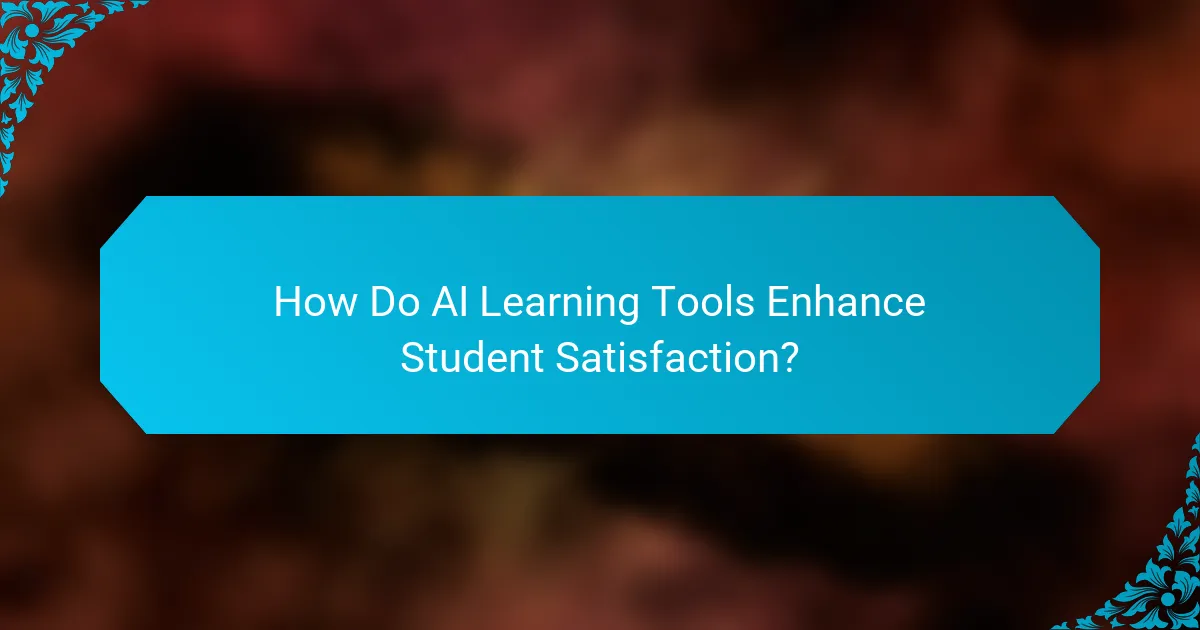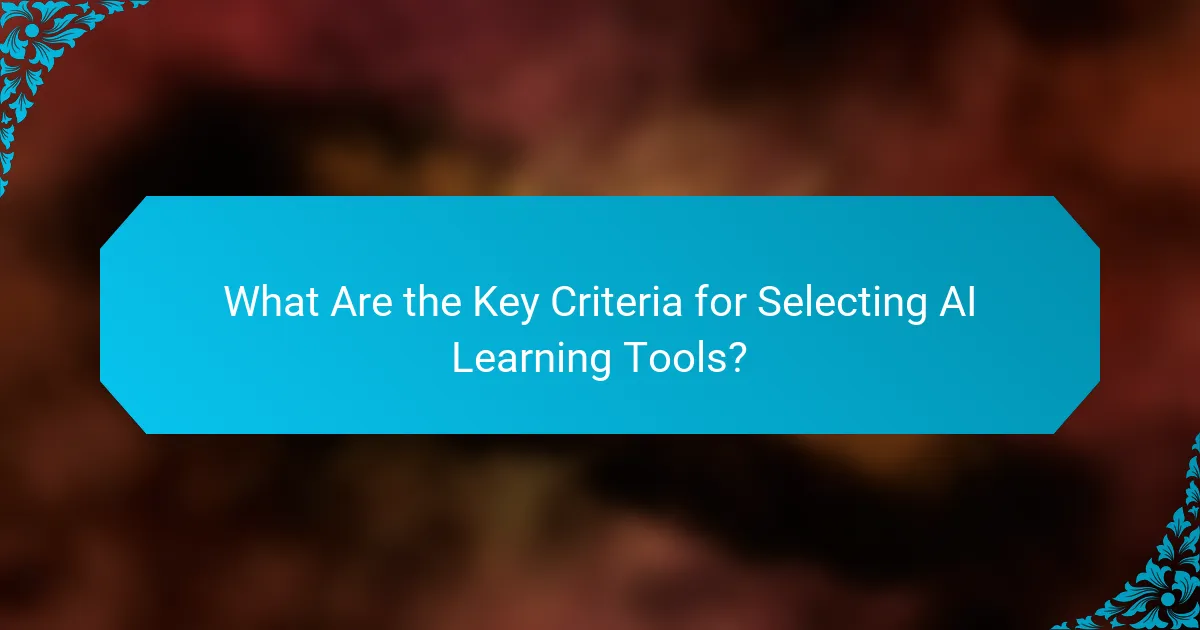AI learning tools are designed with intuitive navigation in mind, ensuring that both students and educators can easily access resources and manage their tasks. By prioritizing user experience, these platforms enhance engagement and satisfaction, ultimately leading to a more effective learning environment tailored to individual needs.

What Are the Best AI Learning Tools for Intuitive Navigation?
The best AI learning tools for intuitive navigation prioritize user experience, making it easy for students and educators to access resources and manage tasks. These platforms often feature streamlined interfaces, clear organization, and responsive design to enhance engagement and satisfaction.
Google Classroom
Google Classroom offers a user-friendly interface that integrates seamlessly with other Google services. Its intuitive navigation allows students to easily find assignments, materials, and feedback, promoting efficient learning.
Key features include a simple dashboard that displays upcoming tasks and a streamlined way to submit work. Educators can create classes, distribute assignments, and communicate with students effortlessly, making it a popular choice in many educational settings.
Microsoft Teams for Education
Microsoft Teams for Education combines communication and collaboration tools with a straightforward navigation system. Users can access class materials, assignments, and discussions all in one place, enhancing the learning experience.
The platform allows for real-time collaboration on documents and projects, which is beneficial for group work. Its integration with other Microsoft 365 tools means students can easily switch between applications without losing focus.
Canvas LMS
Canvas LMS is known for its intuitive navigation and customizable interface. Users can personalize their dashboards, making it easier to prioritize tasks and access course materials quickly.
Canvas supports multimedia content, allowing educators to create engaging lessons. Its mobile-friendly design ensures that students can navigate the platform effectively on various devices, enhancing accessibility.
Blackboard Learn
Blackboard Learn provides a robust learning management system with a focus on intuitive navigation. The platform offers a clear layout that helps users easily locate courses, assignments, and resources.
With features like drag-and-drop file uploads and customizable course menus, Blackboard enhances user experience. However, some users may find the interface slightly complex compared to other tools, so training may be beneficial.
Moodle
Moodle is an open-source learning platform that emphasizes flexibility and user control. Its navigation can be tailored to suit different educational needs, making it adaptable for various institutions.
While Moodle offers a wealth of features, users may need time to familiarize themselves with its layout. Providing training sessions can help maximize its potential and improve user satisfaction.

How Do AI Learning Tools Enhance Student Satisfaction?
AI learning tools significantly enhance student satisfaction by providing tailored educational experiences that meet individual needs. These tools leverage data to adapt content and feedback, fostering a more engaging and effective learning environment.
Personalized Learning Experiences
Personalized learning experiences are a cornerstone of AI learning tools, allowing students to progress at their own pace. By analyzing performance data, these tools can adjust the difficulty of tasks and recommend resources that align with each student’s unique learning style.
For example, a student struggling with math concepts may receive additional practice problems and video tutorials, while another excelling in the subject might be directed to advanced challenges. This customization helps maintain motivation and improves overall comprehension.
Real-time Feedback Mechanisms
Real-time feedback mechanisms are essential for enhancing student satisfaction, as they provide immediate insights into performance. AI tools can assess answers and offer suggestions or corrections almost instantly, allowing students to learn from mistakes without delay.
This immediate feedback loop encourages a growth mindset, as students can quickly identify areas for improvement and adjust their study strategies accordingly. For instance, a language learning app might provide instant pronunciation corrections, helping learners refine their skills effectively.
Engaging Learning Environments
Engaging learning environments created by AI tools contribute significantly to student satisfaction. These tools often incorporate gamification elements, interactive simulations, and multimedia content to make learning more enjoyable and immersive.
By transforming traditional lessons into interactive experiences, such as quizzes with rewards or virtual labs for science experiments, students are more likely to stay engaged. This engagement not only enhances retention but also fosters a positive attitude towards learning.

What Features Should You Look for in AI Learning Tools?
When selecting AI learning tools, prioritize features that enhance intuitive navigation and boost student satisfaction. Key aspects include a user-friendly interface, seamless integration capabilities, and robust analytics and reporting tools.
User-friendly Interface
A user-friendly interface is crucial for ensuring that both students and educators can navigate the AI learning tool effortlessly. Look for platforms that offer clear layouts, intuitive menus, and easy access to resources. Tools that prioritize accessibility, such as adjustable text sizes and color contrasts, can significantly enhance the user experience.
Consider tools that provide customizable dashboards, allowing users to arrange their most-used features prominently. This personalization can save time and make learning more engaging.
Integration Capabilities
Integration capabilities are essential for ensuring that AI learning tools work well with existing educational systems and resources. Look for tools that can easily connect with Learning Management Systems (LMS), content libraries, and other software used in educational settings. This compatibility can streamline workflows and reduce the need for duplicate data entry.
Evaluate the ease of integration by checking if the tool supports popular APIs or offers pre-built connectors. A tool that integrates smoothly can enhance the overall learning experience by providing a cohesive environment for students and instructors.
Analytics and Reporting Tools
Robust analytics and reporting tools are vital for tracking student progress and engagement. Effective AI learning tools should provide insights into learning patterns, performance metrics, and areas needing improvement. Look for features that allow educators to generate customizable reports to assess individual and group performance.
Consider tools that offer real-time analytics, enabling timely interventions when students struggle. This proactive approach can lead to improved outcomes and higher student satisfaction.

How Do AI Learning Tools Compare in Pricing?
AI learning tools vary significantly in pricing, with options ranging from free platforms to premium subscriptions. Understanding these differences is crucial for educators and students looking to maximize their investment in technology for learning.
Free Options vs. Paid Subscriptions
Free AI learning tools often provide basic functionalities that can be sufficient for casual learners or those just starting. However, paid subscriptions typically offer advanced features, enhanced support, and a more comprehensive learning experience.
For instance, platforms like Khan Academy offer free access to a wide range of resources, while tools like Coursera or Udemy may charge fees for specialized courses or certifications. Evaluating the specific needs of users can help determine whether a free option suffices or if a paid subscription is warranted.
Cost of Implementation
The cost of implementing AI learning tools can vary based on the scale of deployment and the specific features required. Schools and institutions may face initial setup costs, including software licenses, training for educators, and integration with existing systems.
On average, educational institutions might spend anywhere from a few hundred to several thousand USD depending on the number of users and the complexity of the tools. It’s essential to budget not only for the software but also for ongoing maintenance and updates.
Long-term Value Assessment
When assessing the long-term value of AI learning tools, consider both the educational outcomes and the total cost of ownership. While a higher upfront cost may seem daunting, the potential for improved student engagement and performance can justify the investment.
Institutions should track metrics such as student satisfaction, retention rates, and learning outcomes over time to evaluate effectiveness. A tool that enhances learning and reduces dropout rates can ultimately save money and improve educational quality in the long run.

What Are the Key Criteria for Selecting AI Learning Tools?
When selecting AI learning tools, focus on intuitive navigation and student satisfaction as primary criteria. These factors ensure that the tools are user-friendly and effectively meet the needs of learners.
Institutional Needs Assessment
Conducting an institutional needs assessment is crucial for identifying the specific requirements of your educational environment. This involves evaluating the existing curriculum, technological infrastructure, and the learning objectives of students and educators.
Gather input from various stakeholders, including faculty, students, and IT staff, to create a comprehensive picture of what features and functionalities are essential. Consider factors such as scalability, integration with current systems, and support for diverse learning styles.
User Feedback and Reviews
User feedback and reviews provide valuable insights into the effectiveness of AI learning tools. Look for platforms that aggregate user experiences, highlighting both strengths and weaknesses of different tools.
Pay attention to common themes in reviews, such as ease of use, responsiveness of customer support, and the impact on student engagement. Tools that consistently receive positive feedback in these areas are more likely to enhance student satisfaction and learning outcomes.
